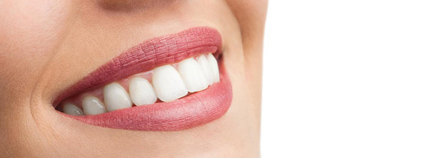Teeth
whitening
PRAXI-DENT
NON-PUBLIC HEALTH CARE CENTRE

Teeth whitening
The process of teeth whitening involves a chemical reaction during which active oxygen, responsible for the whitening process, is produced. It is produced as a result of activation of whitening agents – hydrogen peroxide or carbamide peroxide. Therefore, whitening is not dangerous for the enamel or pulp of teeth. You should remember that whitening does not lighten any fillings, crowns, bridges or porcelain veneers, whatever whitening method is chosen. Discolouration caused by developmental abnormalities, e.g. by dental fluorosis or tetracyclines, may be difficult to treat with whitening, just as non-vital teeth which require additional measures.
There are two methods of professional teeth whitening: in-office (instantaneous) whitening, and overlay (home) whitening.
In-office or instantaneous whitening
Treatment takes about an hour. The Patient’s teeth are first cleaned with a brush, and then the gums are protected with a rubber liquid dam, a light-cure paste that will protect the gums from the whitening agent (its concentration is 30-35 percent). The teeth are dried, the whitening agent is applied and left for about 20 minutes, and the teeth are treated with a whitening accelerator lamp, depending on the agent used. The agent can be applied again at the same appointment. It is often necessary to repeat the treatment after about 2 weeks. During this time, the colour is evening out and the final result will gradually become apparent, so it is recommended that the patient follows the so-called “white diet”, which includes avoiding coffee, tea, tobacco, red wine, and dark juices.
Whitening effect lasts for 1-2 years, and it depends on the patient’s diet as well as on the individual properties of the patient’s tooth enamel.
Home whitening with overlays
For home whitening, agents with lower concentration of 10 or 15 percent are used, depending on the patient’s sensitivity and expected results. The Patient is provided with overlays adjusted to his or her teeth, and created using previously taken impressions. The Patient is to place a whitening agent inside the overlays (only a small amount to prevent it from spilling out onto the gums), and wear the overlays at night or for a few hours during the day. Eating, drinking, or smoking cigarettes is prohibited when wearing the overlay. Such a whitening therapy lasts about two weeks, but the effect can be seen after just two applications.
The “white diet” should also be followed for two weeks after home whitening. After six months, the Patient can repeat the treatment using the same overlays. When so doing, 1-2 applications are usually enough to achieve the desired effect.
Adverse reactions
The most common adverse reaction is temporary tooth sensitivity which varies in intensity (depending on the concentration of the agent and individual sensitivity) and can last for 1-2 days. To prevent this adverse reaction, special desensitising agents are used after the treatment, which can be either applied directly to the teeth (in-office whitening) or placed into the whitening overlays. When overlays are used, overlays applied with a desensitising agent can be worn during the day, or they can be interchanged every other night with overlays applied with a whitening agent.
Another reaction may be irritation of the gums caused by placing too much agent inside the overlays. The irritation subsides within a few days.
